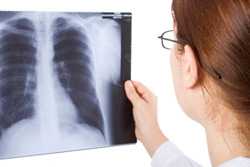Diagnosing latent TB infection and TB disease
 Most persons, but not everyone, with TB disease have one or more symptoms of TB disease. All persons with either symptoms or a positive TB test result should be evaluated for TB disease. If a person has symptoms, but a negative TB test result, they should still be evaluated for TB disease.
Most persons, but not everyone, with TB disease have one or more symptoms of TB disease. All persons with either symptoms or a positive TB test result should be evaluated for TB disease. If a person has symptoms, but a negative TB test result, they should still be evaluated for TB disease.
Diagnosis of Latent TB Infection
A diagnosis of latent TB infection is made if a person has a positive TB test result and a medical evaluation does not indicate TB disease. The decision about treatment for latent TB infection will be based on a person’s chances of developing TB disease by considering their risk factors.
Diagnosis of TB Disease
TB disease is diagnosed by medical history, physical examination, chest x-ray, and other laboratory tests. TB disease is treated by taking several drugs as recommended by a health care provider.
TB disease should be suspected in persons who have any of the following symptoms:
- Unexplained weight loss
- Loss of appetite
- Night sweats
- Fever
- Fatigue
If TB disease is in the lungs (pulmonary), symptoms may include:
- Coughing for longer than 3 weeks
- Hemoptysis (coughing up blood)
- Chest pain
If TB disease is in other parts of the body (extrapulmonary), symptoms will depend on the area affected.
People suspected of having TB disease should be referred for a complete medical evaluation, which will include the following:
 1. Medical History
1. Medical History
Clinicians should ask about the patient’s history of TB exposure, infection, or disease. It is also important to consider demographic factors (e.g., country of origin, age, ethnic or racial group, occupation) that may increase the patient’s risk for exposure to TB or to drug-resistant TB. Also, clinicians should determine whether the patient has medical conditions, such as HIV infection or diabetes, that increase the risk of latent TB infection progressing to TB disease.
2. Physical Examination
A physical exam can provide valuable information about the patient’s overall condition and other factors that may affect how TB is treated, such as HIV infection or other illnesses.
3. Test for TB Infection
The Mantoux tuberculin skin test (TST) or the TB blood test can be used to test for M. tuberculosis infection. Additional tests are required to confirm TB disease.
4. Chest Radiograph
A posterior-anterior chest radiograph is used to detect chest abnormalities. Lesions may appear anywhere in the lungs and may differ in size, shape, density, and cavitation. These abnormalities may suggest TB, but cannot be used to definitively diagnose TB. However, a chest radiograph may be used to rule out the possibility of pulmonary TB in a person who has had a positive reaction to a TST or TB blood test and no symptoms of disease.
5. Diagnostic Microbiology
The presence of acid-fast-bacilli (AFB) on a sputum smear or other specimen often indicates TB disease. Acid-fast microscopy is easy and quick, but it does not confirm a diagnosis of TB because some acid-fast-bacilli are not M. tuberculosis. Therefore, a culture is done on all initial samples to confirm the diagnosis. (However, a positive culture is not always necessary to begin or continue treatment for TB.) A positive culture for M. tuberculosis confirms the diagnosis of TB disease. Culture examinations should be completed on all specimens, regardless of AFB smear results. Laboratories should report positive results on smears and cultures within 24 hours by telephone or fax to the primary health care provider and to the state or local TB control program, as required by law.
6. Drug Resistance
For all patients, the initial M. tuberculosis isolate should be tested for drug resistance. It is crucial to identify drug resistance as early as possible to ensure effective treatment. Drug susceptibility patterns should be repeated for patients who do not respond adequately to treatment or who have positive culture results despite 3 months of therapy. Susceptibility results from laboratories should be promptly reported to the primary health care provider and to the state or local TB control program.
Related Links
For Patients
- TB – General Information (Fact sheet)
- Questions and Answers About TB
For Health Care Providers
- Page last reviewed: April 18, 2016
- Page last updated: April 18, 2016
- Content source:


 ShareCompartir
ShareCompartir